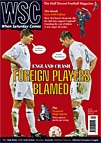 The fall of the Berlin Wall spelled the end of the Oberliga. By Paul Joyce
The fall of the Berlin Wall spelled the end of the Oberliga. By Paul Joyce
The long-term significance
The opening of the Berlin Wall on November 9, 1989, meant free movement for players and fans – and the end of the Oberliga. As reunification gathered pace, the collapse of state organisations that sponsored GDR clubs plunged football in eastern Germany into a financial crisis from which it has yet to recover.
Story of the season
The first hints of change occurred in June 1989. Dynamo Dresden won the league by eight points, ending Dynamo Berlin’s controversial run of ten successive titles. Both sides had police backing, but Stasi boss Erich Mielke’s support for the Berliners gave rise to accusations of systematic favouritism from referees. Professional contracts were introduced in a bid to halt illicit payments from club sponsors to their “amateur” stars. Carl Zeiss Jena players allegedly hid cash in vegetable racks. But it was too little, too late. Six days after the Wall fell, the GDR national team lost 3-0 to Austria in Vienna, having needed only a draw to qualify for the 1990 World Cup. “Their minds were already in the West,” said national coach Eduard Geyer. Bayer Leverkusen smuggled an agent into the match in a photographer’s bib and secured the signing of Dynamo Berlin’s Andreas Thom – the first East German player to move legally to the West. The fee of 3.6 million West German marks (£1.3m) included a million marks’ worth of medicine for the GDR’s Ministry of Health. In February 1990, Dynamo Berlin tried to distance themselves from their Stasi past, renaming themselves FC Berlin. But their attendances plummeted to 1,400 as the absence of Thom and a 6-1 thrashing by Dresden in April saw them drop out of the Oberliga’s closest-ever title race. Three teams were level on points at the top before the final round of matches. In a direct duel, FC Karl-Marx-Stadt won 1-0 against long-time leaders 1.FC Magdeburg, for whom Uwe Rösler scored 11 goals this season. This looked set to give Karl-Marx-Stadt their first title since 1967, as Dresden fell behind at home to Lok Leipzig. Yet with ten minutes to go, 32,867 fans saw the season’s top scorer, Torsten Gütschow, put Dynamo ahead. Dresden’s 3‑1 win gave them the title on goal difference. They also won the FDGB Cup, defeating second-division PSV Schwerin 2-1 in front of only 5,750. At the bottom, three teams were also level on points. With their second victory of the season, Eisenhüttenstadt beat rivals Bischofswerda 2-0 to stay up. Despite a 4-1 win at FC Berlin, Wismut Aue were relegated after 39 years in the Oberliga. Three Aue players had defected to the West before the start of the season. The exodus continued in the summer of 1990. Dresden lost five players who had helped them reach the 1989 UEFA Cup semi-finals, including Matthias Sammer (VfB Stuttgart) and Ulf Kirsten (Leverkusen). Lower-league sides fared worse. Motor Ludwigsfelde, who had lost 13 players by February 1990, were one of six second-division clubs to withdraw from the league.
For the record books
Germany was reunified on October 3, 1990. The Oberliga carried on for another season as a qualification round for the new Bundesliga. Only two GDR teams, 1991 champions Hansa Rostock and runners-up Dresden, were allowed to join the top flight. Six sides entered the 2.Bundesliga.
Same place today
By 2005, there were no teams from the former GDR left in the Bundesliga, although Energie Cottbus and Hansa Rostock have since regained top-flight status. Aue and Jena are the region’s only second-division representatives.
Moved furthest away
Where do you start? Brandenburg, Eisenhüttenstadt and Bischofswerda have sunk to the sixth tier of German football. Lok Leipzig have risen to the fifth level, after going bankrupt in 2004 and restarting at the bottom of the pyramid. The other six Oberliga clubs from 1989-90 play in the third and fourth divisions.
From WSC 251 January 2008